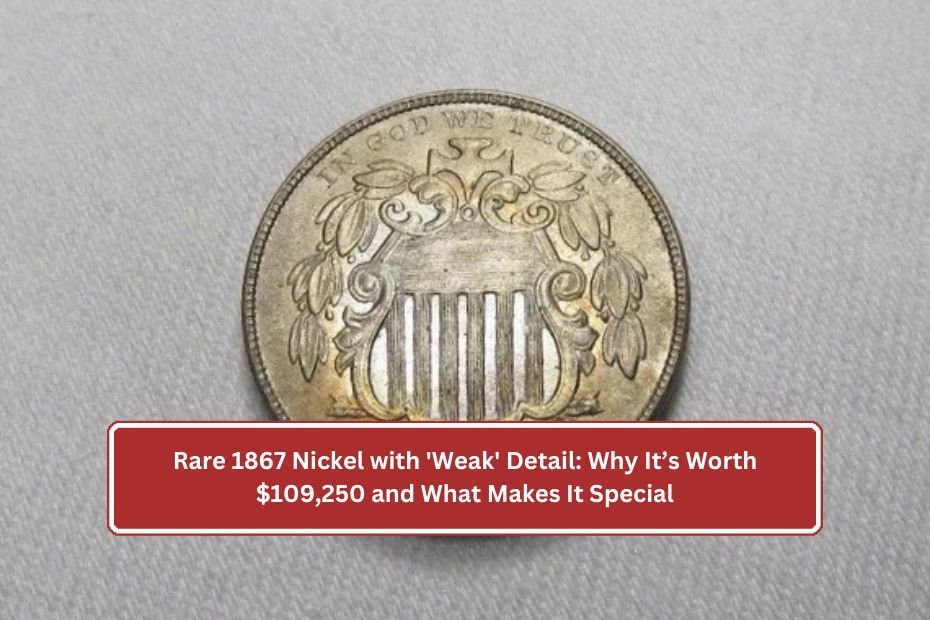A unique 1867 nickel recently sold for $109,250 due to its rare characteristics and historical significance. This nickel, a 5C Rays PR66 Cameo, stands out for having “weak” details that make it especially valuable to collectors. These subtle imperfections, combined with the coin’s 1867 date, create high demand among collectors.
Let’s look at what makes this coin so valuable, including its distinctive features, grading details, and why 1867 was such an important year for coins like this one.
Why the 1867 Nickel Stands Out
The 1867 nickel, known as the 5C Rays PR66 Cameo, holds particular importance in numismatics. Its rare traits and historical significance have contributed to its $109,250 value. Here are some specific reasons this nickel stands out:
Key Characteristics
- Date and Unique Marks: The “1” in the date is aligned over a dentil (a tiny tooth-like detail on the edge), and the “7” has a unique re-cut design.
- Detached Leaf: A detached leaf below “TRUST” on the shield’s right side makes this coin unique.
- Weak Reverse Ray: The reverse side shows a “weak” center ray below the “T” in “STATES,” a rare feature for nickels from this period.
- Champagne Patina: This coin has an untoned, reflective surface with a light champagne hue at its center, adding visual appeal.
Why 1867 Nickel are So Valued
The year 1867 represents a transitional period for U.S. coins. During this time, the “With Rays” design on nickels was limited, making them much rarer than coins from other years. Coins from 1867 are cherished not only for their age but also for their unique designs and striking techniques, adding to their appeal in the collector’s market.
Understanding the Grading Process
The Professional Coin Grading Service (PCGS) assigned this 1867 nickel a grade of PR66, which stands for “Proof 66.” Proof coins are struck with specially prepared dies and blanks, ensuring high detail. A PR66 grade indicates excellent condition with only minor flaws, making this particular nickel especially attractive to collectors.
Grading is essential in determining a coin’s worth, and factors such as luster, coloration, and unique minting characteristics play a role in grading. Here are the main grades coins can have:
| Grade | Description |
|---|---|
| PR (Proof) | Specially struck for collectors; often high-quality. |
| MS (Mint State) | Regular coins, uncirculated, with grades from 60-70. |
| AU (Almost Uncirculated) | Coins showing minimal wear. |
| EF (Extremely Fine) | Detailed, with some signs of circulation wear. |
This table shows the different coin grades that help collectors determine value. A high-quality grade like PR66 can increase a coin’s market appeal and price.
How to Identify Valuable Nickels
Collectors should carefully examine their nickels for specific details. Here are a few tips to identify rare coins like the 1867 nickel:
- Look for mint marks, year, and unique features on both sides.
- Check the coin’s condition—well-preserved coins hold more value.
- Seek third-party grading services like PCGS or CAC to certify your coin’s grade.
Conclusion
The 1867 5C Rays PR66 Cameo nickel is a perfect example of how rare details and historical context can raise a coin’s value. Its weak design features, reflective surfaces, and unique marks appeal to collectors worldwide, making it a prized addition to any collection. This one-of-a-kind nickel highlights the fascination of coin collecting and the excitement of finding hidden treasures in old coins.
FAQ’s
What makes the 1867 nickel valuable?
The 1867 nickel’s value comes from its rare characteristics, historical significance, and high grading (PR66), which make it highly collectible.
How does coin grading affect value?
Higher grades reflect better preservation and detail, increasing a coin’s value. Third-party services help confirm a coin’s authenticity and grade.
Why are 1867 nickels special for collectors?
The 1867 nickel represents a transitional minting period and has unique design details, making it sought after by coin enthusiasts.

